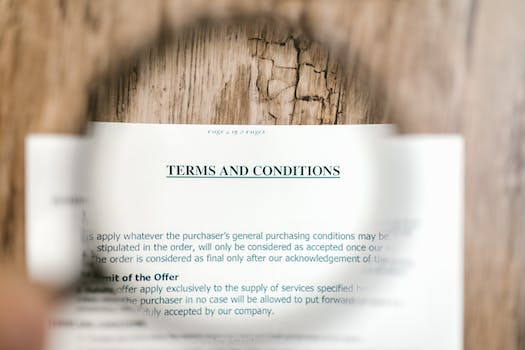Terms and Conditions

How to Draft an Effective Terms and Conditions Agreement
Creating a Terms and Conditions agreement is an important step for any business. It helps protect your business from potential legal issues and sets expectations for customers. Here are some tips to help you draft an effective Terms and Conditions agreement.
1. Keep it simple. Your Terms and Conditions should be easy to understand and written in plain language. Avoid using legal jargon or overly complex language.
2. Be specific. Make sure to include all the details of your agreement, such as payment terms, delivery times, and any other relevant information.
3. Include disclaimers. Disclaimers help protect your business from potential legal issues. Make sure to include disclaimers for any services or products you offer.
4. Make it accessible. Your Terms and Conditions should be easy to find on your website or app. Make sure to include a link to the agreement in any emails or other communications you send to customers.
5. Update regularly. As your business grows and changes, make sure to update your Terms and Conditions to reflect any new services or products you offer.
Creating a Terms and Conditions agreement is an important step for any business. Following these tips can help you draft an effective agreement that will protect your business and set expectations for customers.
The Pros and Cons of Including an Arbitration Clause in Your Terms and Conditions
When it comes to protecting your business, including an arbitration clause in your terms and conditions is a great way to ensure that any disputes are handled quickly and efficiently. But, as with any legal document, there are pros and cons to consider before you decide to include an arbitration clause in your terms and conditions.
Pros
1. Speed: Arbitration is a much faster process than going to court. This means that any disputes can be resolved quickly and efficiently, without the need for lengthy court proceedings.
2. Cost: Arbitration is usually much cheaper than going to court. This can be a great benefit for businesses that are on a tight budget.
3. Privacy: Arbitration is a private process, which means that any disputes are kept out of the public eye. This can be beneficial for businesses that want to keep their disputes confidential.
Cons
1. Limited Appeal: Once an arbitration decision has been made, it is usually final and cannot be appealed. This means that if you are unhappy with the outcome, you may not be able to do anything about it.
2. Limited Discovery: In arbitration, the parties are usually limited in the amount of evidence they can present. This can be a disadvantage if you need to present a lot of evidence to support your case.
3. Limited Remedies: Arbitration usually only allows for monetary damages, which means that other remedies such as injunctions or specific performance may not be available.
Overall, including an arbitration clause in your terms and conditions can be a great way to protect your business and ensure that any disputes are handled quickly and efficiently. However, it is important to consider the pros and cons before you decide to include an arbitration clause in your terms and conditions.
What to Consider When Writing Terms and Conditions for Your Website
1. Make sure your terms and conditions are easy to understand. Use plain language and avoid legal jargon.
2. Make sure your terms and conditions are comprehensive. Include all the necessary information about your website, such as what users can and cannot do, how you will handle disputes, and what happens if the user violates the terms.
3. Make sure your terms and conditions are up to date. Laws and regulations change over time, so make sure your terms and conditions reflect the current legal landscape.
4. Make sure your terms and conditions are legally binding. Include a clause that states that the user agrees to the terms and conditions when they use your website.
5. Make sure your terms and conditions are enforceable. Include a clause that states that the user agrees to be bound by the terms and conditions and that any disputes will be resolved in accordance with the law.
6. Make sure your terms and conditions are tailored to your website. Include clauses that are specific to your website, such as how you will handle user data or how you will handle copyright infringement.
7. Make sure your terms and conditions are clear about the consequences of violating the terms. Include a clause that states that the user may be subject to legal action if they violate the terms and conditions.
8. Make sure your terms and conditions are easy to find. Include a link to the terms and conditions on every page of your website.
How to Ensure Your Terms and Conditions are Compliant with GDPR
If you’re a business owner, you’ve likely heard of the General Data Protection Regulation (GDPR). This is a set of regulations that was put in place to protect the personal data of individuals in the European Union (EU). As a business, it’s important to make sure that your Terms and Conditions are compliant with GDPR. Here are some tips to help you ensure that your Terms and Conditions are compliant with GDPR.
1. Make sure your Terms and Conditions are clear and easy to understand.
Your Terms and Conditions should be written in plain language that is easy to understand. Avoid using legal jargon or overly complicated language. Make sure that your Terms and Conditions clearly explain what data you collect, how you use it, and how you protect it.
2. Explain how you use personal data.
Your Terms and Conditions should explain how you use personal data. This includes how you collect it, how you store it, and how you use it. Make sure that you are transparent about how you use personal data and that you are only using it for the purposes that you have stated.
3. Explain how you protect personal data.
Your Terms and Conditions should explain how you protect personal data. This includes what security measures you have in place to protect data, such as encryption and firewalls. Make sure that you are transparent about how you protect personal data and that you are taking all necessary steps to ensure its security.
4. Explain how individuals can access their data.
Your Terms and Conditions should explain how individuals can access their data. This includes how they can request a copy of their data, how they can update their data, and how they can delete their data. Make sure that you are transparent about how individuals can access their data and that you are providing them with the necessary tools to do so.
5. Explain how individuals can opt-out of data collection.
Your Terms and Conditions should explain how individuals can opt-out of data collection. This includes how they can opt-out of receiving emails, how they can opt-out of being tracked online, and how they can opt-out of having their data shared with third parties. Make sure that you are transparent about how individuals can opt-out of data collection and that you are providing them with the necessary tools to do so.
By following these tips, you can ensure that your Terms and Conditions are compliant with GDPR. This will help protect the personal data of individuals in the EU and ensure that your business is compliant with the regulations.
The Benefits of Having a Clear and Comprehensive Terms and Conditions Agreement
Having a clear and comprehensive terms and conditions agreement is essential for any business. It helps protect both the business and its customers by setting out the expectations and responsibilities of each party. Here are some of the benefits of having a clear and comprehensive terms and conditions agreement:
1. It helps protect your business: A terms and conditions agreement helps protect your business by setting out the rules and regulations that customers must follow when using your services or products. This helps to ensure that customers understand their rights and responsibilities, and that they are aware of any potential risks associated with using your services or products.
2. It helps protect your customers: A terms and conditions agreement also helps protect your customers by setting out the expectations and responsibilities of both parties. This helps to ensure that customers are aware of any potential risks associated with using your services or products, and that they understand their rights and responsibilities.
3. It helps to avoid disputes: Having a clear and comprehensive terms and conditions agreement helps to avoid disputes between you and your customers. This is because it sets out the expectations and responsibilities of both parties, which helps to ensure that both parties understand their rights and responsibilities.
4. It helps to establish trust: Having a clear and comprehensive terms and conditions agreement helps to establish trust between you and your customers. This is because it sets out the expectations and responsibilities of both parties, which helps to ensure that both parties understand their rights and responsibilities.
Overall, having a clear and comprehensive terms and conditions agreement is essential for any business. It helps protect both the business and its customers by setting out the expectations and responsibilities of each party. It also helps to avoid disputes, and helps to establish trust between you and your customers.